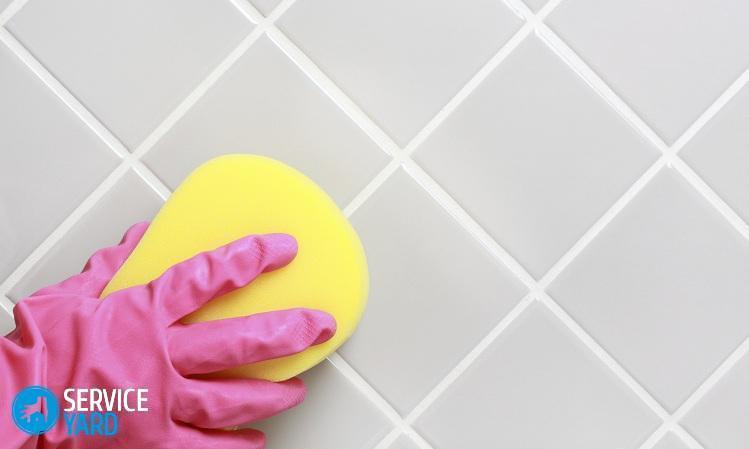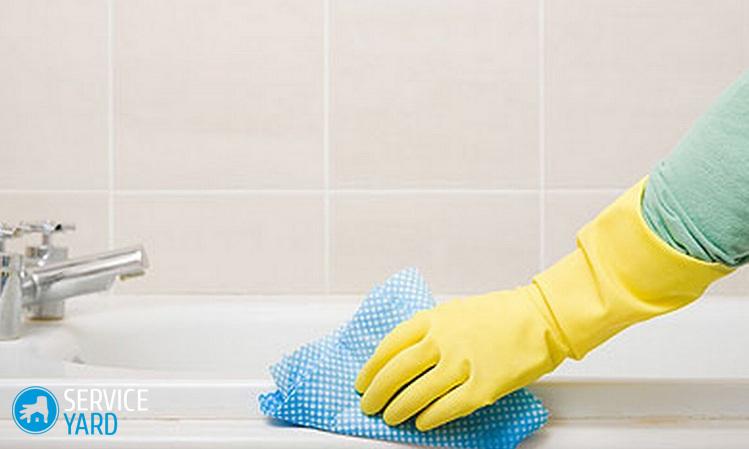How to remove plaque in the bathroom?

The hardness of the water creates many difficulties for housewives, including annoying deposits of lime in the bathroom and on other surfaces that come in contact with water. It appears gradually as a result of the subsidence of insoluble magnesium and calcium compounds contained in tap water, and it is rather difficult to wash.
As a result, the glossy and snow-white surface of the sanitary equipment is covered with a layer of beige substance, because of which it becomes dull and it becomes difficult to clean it. And the presence of rust in the water supply system can further complicate the problem of how to remove plaque in the bathroom, completely ruining the appearance of the bathroom with reddish smudges.
There are many methods to deal with these types of pollution. But which one is better to apply in your case in order to effectively clean the surface will depend on the list of individual factors that must be taken into account when choosing.
to contents ↑Causes
Let's take a closer look at the types of plaque, as well as the reasons for its appearance:
Plaque on plumbing
Due to the fact that plumbing products often and actively interact with water, lime deposits quickly form on them. The water that flows through our sewer pipes is full of lime and various minerals. After the water gets to the surface and evaporates, particles of lime form in its place. At first they are barely noticeable, but as the number of particles grows, the plaque thickness also increases.
Important! Limestone can appear both on the toilet, in which the drain tank flows, and on the bathroom, on taps, on pipes. In addition to spoiling the appearance of the product, it also complicates the process of its operation.
Plaque on the walls
When we talk about plaque that is present on the walls of the bathroom, we mean soap plaque that has formed not only on tiles, but also on the surfaces of PVC panels, wall paneling. When hot water is mixed with a detergent, it settles on the walls in the form of water vapor and leaves a thin soapy coating on them, which can be quite easily removed at first. But over time, it becomes more difficult to clean it.
Fungal plaque
High humidity in the room contributes to the active development of all kinds of fungi, which, as a rule, can be found at the joints between the wall and the bathroom, at the seams between the tiles and in places difficult to clean.
Important! Such plaque not only spoils the appearance, but is also extremely harmful to health. Therefore, it is necessary to fight it with the help of antibacterial agents.
Crane raid
Since most modern houses today use nickel-plated taps and faucets, any stains on them become noticeable instantly. If they are not constantly cleaned, then lime and soapy deposits form on them.
to contents ↑Important! If the tap leaks, then you may also encounter a rust problem. It’s the hardest to clean. Also, rust from the tap can paint other non-metallic surfaces, such as the bottom of the bathtub or sink. Therefore, the fight against rust must be started in a timely manner.
Folk remedies in the fight against limescale
To effectively clean the plaque in the bathroom, you can use one of the proven folk remedies, namely:
- Acetic acid with a concentration of at least 25% - a solution should be prepared by mixing the acid with water in a ratio of 1:20. It is best to dilute it with boiling water, and then let the solution cool.
Important! This solution can remove plaque on metallized, glass, enamelled, nickel-plated and earthenware surfaces. But for use on plastic and acrylic bathtubs, it will not work.
- Citric acid cleans the surface more delicately, so it can be used on any materials. In order for the acid to produce the desired effect, it should be applied with a sponge to all surfaces that need to be cleaned for up to 3 hours. After that, it must be washed off with warm water.
- Oxalic acid is often used in many commercial cleaning products. If you would like to find a milder way of cleaning, then you yourself can prepare a solution of water, which is mixed with oxalic acid (usually a 5% solution is used), apply it on a contaminated surface for a couple of hours.
- Hydrochloric acid can also be used in the fight against limescale - maximum caution should be exercised here. Under no circumstances should hydrochloric acid get on the skin or on the metal surface. But it is great for removing rust from enameled surfaces. After applying hydrochloric acid, the surface should be thoroughly washed with cold running water and treated with a normal detergent.
- A mixture of hydrogen peroxide and ammonia - A less dangerous way to clean plaque in the bathroom. Mix hydrogen peroxide with ammonia in a ratio of 1: 2 in a separate container, apply the mixture to a sponge and wipe it with contaminated places. Rinse off after 15 minutes.
- Some housewives recommend baking soda to eliminate plaque - but you must be careful with this product, as abrasive particles can scratch the surface.
Chemicals for the elimination of limescale
Removing water stone in the bathroom with chemicals is much easier and faster. You do not need to measure the necessary proportions and mix the solutions yourself. All of the required components in purchased cleaning products have already been used. You just have to put the cleaning agent on a cloth, wipe it with a contaminated surface and rinse off any residue with plain water.
Chemical detergents can be bought in the form of a spray, powder or gel. On the shelves you can find the following:
- Frosch.
- Sano Anti Kalk Rush.
- Clin.
- Cillit Bang.
- Cif.
- Hg.
Before buying, be sure to carefully read the information on the label. It should indicate not only the method of application, but also which surfaces this tool is intended for. So, for example, for acrylic baths you can not use abrasive powders and cleaning products that contain acids in their composition.
Important! The more concentrated the cleaning agent, the less time it will need to be kept on a contaminated surface. This time period can vary from a couple of minutes to several hours.
If you need to remove old plaque, then once you are unlikely to succeed in achieving the desired effect. The cleaning procedure must be carried out several times before the coating is completely washed off.
to contents ↑Surface application
The type and material of the surface on which the plaque appeared will largely depend on how the plaque can be cleaned in the bathroom:
- The most unpretentious product made of cast iron - they can be processed by almost any means, except for strong types of acids, for example, hydrochloric.
- Chromed and enameled surfaces cannot be cleaned with powders and other abrasive products that can impair the integrity of the coating - they should be cleaned with various aqueous solutions, sprays, gels and other liquid products. This also applies to porcelain and glass products. To eliminate plaque on enamel and restore its whiteness, bleach will also help.
- An acrylic bathtub requires the most careful treatment - it can only be cleaned with natural acids or specialized means for cleaning acrylic surfaces. After processing the acrylic surface with acid solutions, experts recommend neutralizing its effect with any alkaline detergent.
Yellow plaque in the bath
Water flowing from our taps often contains iron impurities. As a rule, after it dries, yellow spots of rust remain in the bathroom and in the sink. To prevent their formation, bleach should be used regularly.
If rust stains become too noticeable and a simple bleach does not cope with them, this tool will help you:
- Prepare 50 g of vinegar, 50 g of bleach and 2 tablespoons of food and soda ash.
- First, apply a mixture of soda ash and baking soda to the wet surface, which must be rubbed in smooth circular movements for 10 minutes.
- After that, apply the mixture of vinegar and bleach on top and leave for 30 minutes.
- In the end, just rinse the surface with running water.
Precautionary measures
In order not to work out, as in the well-known proverb “they wanted the best, but it turned out, as always”, before starting cleaning in the bathroom, you should carefully read the instructions on the package of the cleaning agent. If you are using it for the first time, at first it is better to try it on a small, inconspicuous area, and not process the entire bath at once.
to contents ↑Important! In order to remove plaque in the bathroom, it is undesirable to use hard metal brushes that can scratch the surface. It is better to resort to the help of sponges and soft rags. In extreme cases - brushes with soft bristles.
Prevention
In the fight against limescale, the main thing is preventive measures:
- The more often you carry out the procedures for washing the bathroom, the less likely it is that you will have to face the problem of stubborn plaque.
- As a prevention in the fight against plaque, it is not necessary to use potent agents. For these purposes, ordinary powder, dishwashing liquid, liquid soap - in general, all that you can find in your home are quite suitable.
- If you are too lazy to wash off detergents after application, use a glass cleaner. As a rule, they are made on the basis of alcohol, so such products instantly evaporate, and all the dirt remains on a rag.
to contents ↑Important! To effectively combat mold and mildew, at least once a week, treat the bath with chlorine-based detergents or just mild solutions of whiteness or bleach. However, remember that you can not mix chlorine with acids at the same time, because in this case, chlorine fumes become toxic.
Useful Tips:
- The enameled bath, which has undergone restoration, is equal to acrylic for care, because the enamel, which was applied outside the factory, did not pass hardening. Therefore, such a bath requires soft and gentle care.
- If in order to remove plaque in the bath, you have chosen a powder product, then it is better not to pour it into an empty bath - the product “hits” your nose badly, which is very bad for your health. In order to protect yourself, it is better to put a small amount of water in the bathtub, pour in the product there and rub the resulting slurry into the contaminated places, and then rinse everything off with water.
- It is necessary to eliminate the limestone not only from the bathtub itself and the taps, but also to monitor the condition of the shower inside.To do this, it is recommended to unscrew the shower head and pour in a weak solution of acetic acid. Then screw the head back and leave for a couple of hours. After a while, simply open the water so that limescale can be removed.
Stock footage
As you can see, there are many ways to remove plaque in the bathroom. What is better to choose - a ready-made product from the store or to resort to folk recipes, decide for yourself, the main thing is to always read the instructions on the package and observe safety precautions.
- How to choose a vacuum cleaner taking into account the characteristics of the house and coatings?
- What to look for when choosing a water delivery
- How to quickly create comfort at home - tips for housewives
- How to choose the perfect TV - useful tips
- What to look for when choosing blinds
- What should be running shoes?
- What useful things can you buy in a hardware store
- Iphone 11 pro max review
- Than iPhone is better than Android smartphones





